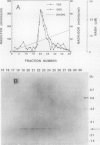Abstract
Plasma membranes isolated from three-day-old maize (Zea mays L.) roots by aqueous two-phase partitioning were used as starting material for the purification of a novel electron transport enzyme. The detergent-solubilized enzyme was purified by dyeligand affinity chromatography on Cibacron blue 3G-A-agarose. Elution was achieved with a gradient of 0 to 30 micromolar NADH. The purified protein fraction exhibited a single 27 kilodalton silver nitrate-stained band on sodium dodecyl sulfate polyacrylamide gel electrophoretograms. Staining intensity correlated with the enzyme activity profile when analyzed in affinity chromatography column fractions. The enzyme was capable of accepting electrons from NADPH or NADH to reduce either ferricyanide, juglone, duroquinone, or cytochrome c, but did not transfer electrons to ascorbate free-radical or nitrate. The high degree of purity of plasma membranes used as starting material as well as the demonstrated insensitivity to mitochondrial electron transport inhibitors confirmed the plasma membrane origin of this enzyme. The purified reductase was stimulated upon prolonged incubation with flavin mononucleotide suggesting that the enzyme may be a flavoprotein. Established effectors of plasma membrane electron transport systems had little effect on the purified enzyme, with the exception of the sulfhydryl inhibitor p-chloromercuriphenyl-sulfonate, which was a strong inhibitor of ferricyanide reducing activity.
Full text
PDF





Images in this article
Selected References
These references are in PubMed. This may not be the complete list of references from this article.
- Bensadoun A., Weinstein D. Assay of proteins in the presence of interfering materials. Anal Biochem. 1976 Jan;70(1):241–250. doi: 10.1016/s0003-2697(76)80064-4. [DOI] [PubMed] [Google Scholar]
- Bradford M. M. A rapid and sensitive method for the quantitation of microgram quantities of protein utilizing the principle of protein-dye binding. Anal Biochem. 1976 May 7;72:248–254. doi: 10.1016/0003-2697(76)90527-3. [DOI] [PubMed] [Google Scholar]
- Brightman A. O., Barr R., Crane F. L., Morré D. J. Auxin-Stimulated NADH Oxidase Purified from Plasma Membrane of Soybean. Plant Physiol. 1988 Apr;86(4):1264–1269. doi: 10.1104/pp.86.4.1264. [DOI] [PMC free article] [PubMed] [Google Scholar]
- Costa L., Malatesta V., Morazzoni F., Scotti R., Monti E., Paracchini L. Direct detection of paramagnetic species in adriamycin perfused rat hearts. Biochem Biophys Res Commun. 1988 May 31;153(1):275–280. doi: 10.1016/s0006-291x(88)81218-x. [DOI] [PubMed] [Google Scholar]
- Gallagher S. R., Leonard R. T. Electrophoretic characterization of a detergent-treated plasma membrane fraction from corn roots. Plant Physiol. 1987 Feb;83(2):265–271. doi: 10.1104/pp.83.2.265. [DOI] [PMC free article] [PubMed] [Google Scholar]
- Guerrini F., Valenti V., Pupillo P. Solubilization and Purification of NAD(P)H Dehydrogenase of Cucurbita Microsomes. Plant Physiol. 1987 Nov;85(3):828–834. doi: 10.1104/pp.85.3.828. [DOI] [PMC free article] [PubMed] [Google Scholar]
- Laemmli U. K. Cleavage of structural proteins during the assembly of the head of bacteriophage T4. Nature. 1970 Aug 15;227(5259):680–685. doi: 10.1038/227680a0. [DOI] [PubMed] [Google Scholar]
- Luster D. G., Bowditch M. I., Eldridge K. M., Donaldson R. P. Characterization of membrane-bound electron transport enzymes from castor bean glyoxysomes and endoplasmic reticulum. Arch Biochem Biophys. 1988 Aug 15;265(1):50–61. doi: 10.1016/0003-9861(88)90370-0. [DOI] [PubMed] [Google Scholar]
- Luster D. G., Donaldson R. P. Orientation of electron transport activities in the membrane of intact glyoxysomes isolated from castor bean endosperm. Plant Physiol. 1987 Nov;85(3):796–800. doi: 10.1104/pp.85.3.796. [DOI] [PMC free article] [PubMed] [Google Scholar]
- Markwell M. A., Haas S. M., Tolbert N. E., Bieber L. L. Protein determination in membrane and lipoprotein samples: manual and automated procedures. Methods Enzymol. 1981;72:296–303. doi: 10.1016/s0076-6879(81)72018-4. [DOI] [PubMed] [Google Scholar]
- Merril C. R., Goldman D., Van Keuren M. L. Silver staining methods for polyacrylamide gel electrophoresis. Methods Enzymol. 1983;96:230–239. doi: 10.1016/s0076-6879(83)96021-4. [DOI] [PubMed] [Google Scholar]
- Pardini R. S., Tilka M. A., Pritsos C. A., Lin A. J., Sartorelli A. C. Characterization of 2,3-bis(chloromethyl)-1,4-naphthoquinone induced mitochondrial swelling. Chem Biol Interact. 1981 May;35(2):241–253. doi: 10.1016/0009-2797(81)90147-2. [DOI] [PubMed] [Google Scholar]
- Peskin A. V., Bartosz G. One-electron reduction of an anthracycline antibiotic carminomycin by a human erythrocyte redox chain. FEBS Lett. 1987 Jul 13;219(1):212–214. doi: 10.1016/0014-5793(87)81218-8. [DOI] [PubMed] [Google Scholar]
- Redinbaugh M. G., Campbell W. H. Purification and Characterization of NAD(P)H:Nitrate Reductase and NADH:Nitrate Reductase from Corn Roots. Plant Physiol. 1981 Jul;68(1):115–120. doi: 10.1104/pp.68.1.115. [DOI] [PMC free article] [PubMed] [Google Scholar]
- Sun I. L., Crane F. L., Löw H., Grebing C. Inhibition of plasma membrane NADH dehydrogenase by adriamycin and related anthracycline antibiotics. J Bioenerg Biomembr. 1984 Jun;16(3):209–221. doi: 10.1007/BF00751050. [DOI] [PubMed] [Google Scholar]
- Sun I. L., Navas P., Crane F. L., Morré D. J., Löw H. NADH diferric transferrin reductase in liver plasma membrane. J Biol Chem. 1987 Nov 25;262(33):15915–15921. [PubMed] [Google Scholar]



